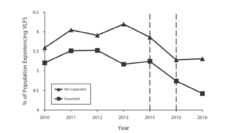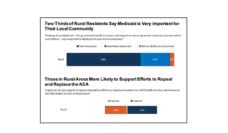Being poor in America comes with tough choices as families face competing demands for limited resources. The cost of filling a prescription may compromise the ability to make rent, for example. Almost 40% of Americans report difficulty meeting their basic needs, including paying for housing. As rents continue to rise and wages among working-class Americans stagnate, millions of families face the risk of housing eviction. Evictions have lasting consequences for individuals and families, including an increased likelihood of homelessness, poverty, and poor health.
Having health insurance can protect the finances of low-income families and reduce the probability of eviction. Multiple studies have shown that increased access to Medicaid is associated with improved financial security. Based on this literature, we hypothesized that the Affordable Care Act (ACA) Medicaid expansions could reduce evictions by freeing up financial resources for spending on non-healthcare needs, such as housing. It is also possible that improved access to health care can lead to better physical and mental health, perhaps strengthening ties to the workforce and increasing household income and housing security.
We recently published two studies examining the impact of Medicaid expansion on evictions, using different data sources and expansion periods in each paper. The first approach, published in Health Affairs, focused on an early 2008-2013 expansion of Medicaid in California using data from a commercial database of eviction records that landlords rely on to screen potential tenants. The second approach, published in the American Journal of Public Health, examined the nationwide impacts of the Medicaid expansions and used public data compiled by Evicted author Matthew Desmond and his team in the Eviction Lab at Princeton. For both papers, we compared county eviction rates before and after expansion, using counties that never expanded Medicaid as controls.
The link between housing stability and Medicaid suggests that costs for health and housing may be coming into direct competition for families already on the brink.
In California, we found that Medicaid expansion was associated with 24.5 fewer evictions per month in each county compared to mean average of 224.7 evictions in control counties. This translates to 22 fewer evictions per 1,000 new enrollees per year. Nationwide, Medicaid expansion was associated with a reduction in 1.16 evictions per 1,000 renter-occupied households per year as well as a reduction in eviction initiations of 1.65 per 1,000 renter-occupied households per year.
When we standardized the units of measurement between our articles, we found Medicaid expansion was associated with a consistent decline in evictions, ranging between approximately 50 and 300 fewer evictions per county per year. California experienced a larger reduction in evictions than the nationwide findings in part due to higher pre-expansion averages in California and differences in the units of measurements.
The degree to which Medicaid was associated with declines in evictions is consistent with what is known about the financial impacts of Medicaid expansion on financial security. Other research on this topic found decreased eviction rates of 12.5%, or one fewer eviction per 400 renting households. Similar studies have found an 11 to 16% reduction in adverse financial outcomes in Michigan and a $100 reduction in annual out-of-pocket medical spending per Medicaid recipient. Additionally, Medicaid has been credited with reducing payday loan borrowing, reducing catastrophic medical debt, and reducing poverty.
The link between housing stability and Medicaid suggests that costs for health and housing may be coming into direct competition for families already on the brink. Some states are using Medicaid to pay for housing, an approach that could further improve both housing stability and health for Medicaid recipients. Our research suggests that receipt of Medicaid itself is a vehicle for improving housing stability among low-income populations.
Photo by Henry Dixon on Unsplash















